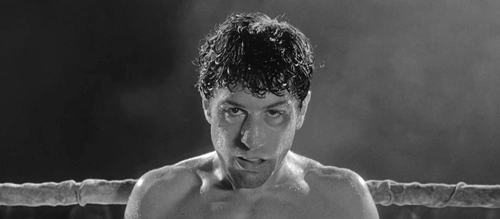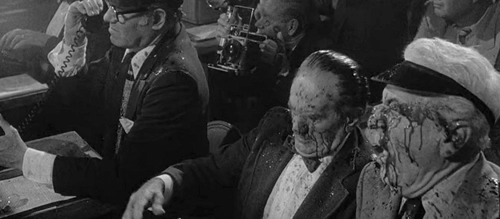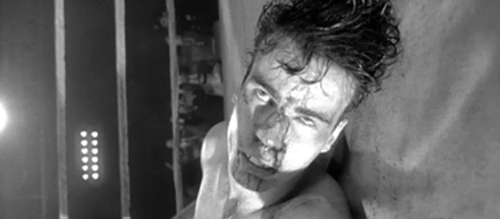The Importance of Expressionism in ‘Raging Bull’
Martin Scorsese’s 1980 biopic Raging Bull narrates one man’s tumultuous struggle with inner demons. Muted, monochromatic aesthetics are fused with visceral displays of graphic violence in this captivating spectacle. The film’s idiosyncratic approach renders it teetering on a stylistic knife edge between conventional Hollywood and the avant-garde. Based on an autobiography of the same name, the film documents the life of Jake LaMotta, a 1940s American middleweight boxer. Whilst the film is known for Robert De Niro’s Academy Award winning method acting, it is Scorsese’s expressionist techniques that elucidate the extent of LaMotta’s psychological turmoil.

During LaMotta’s fight against Janiro, blood spurts from the latter’s face in an unrealistic, exaggerated way – one that resembles a burst pipe more than a wound. The judge’s table is doused with such velocity that blood appears to have been hosed from behind the camera. We then see the glasses of ringside photographers simultaneously splattered with blood in an absurd, cartoon-like fashion. Expressionist techniques, of which these are an example, seek to diverge from objective portrayal and distort visual reality in order to convey the psychological states of characters. In this case, the exaggerated presence of blood acquires thematic value to illustrate LaMotta’s excessive appetite for violence. Kasia Boddy points out that exploding flash bulbs and powerfully amplified punches not only act as ‘scoring music’, but make the violent display even more ‘surreal and abstract’.

The use of black-and-white dampens the appearance of graphic violence by making blood less visually prominent than if it was red. The monochromatic, high contrast duality embodies the motif of LaMotta’s internal struggle between good and evil. Even in the most nauseating instances of violence, monochrome gives the film something of an aesthetic quality, evoking early cinema such as German Expressionism and Film Noir. To give blood a stark appearance, Scorsese used Hershey’s Chocolate – the same material used in Alfred Hitchcock’s Psycho. The classical opera that underscores much of the film, most notable of which is Pietro Mescagni’s Cavalleria Rusticana, instils Raging Bull with an artistic sense of grandeur.
But aestheticizing violence is not the same as glorifying it. Despite the use of conventional Hollywood techniques to make fight scenes engaging, such as fast cutting and amplified punching sounds, Scorsese presents violence unfavourably. This is done by aligning our subjectivity with the characters on the receiving end. After LaMotta knocks Janiro unconscious, a slow-motion descending pedestal shot follows his fall to the ground. Starting at eye height, the camera descends at the same speed as Janiro’s fall, rotating ninety degrees in unison with his head as it hits the canvas. By forcing us to incur Janiro’s subjectivity, somewhat of a shared experience is created between him and us, furthering our detachment from LaMotta.

Expressionist temporal manipulation is used in the Sugar Ray Robinson fight. The shot of LaMotta waiting for Robinson to stand after being knocked down runs in slow motion, conveying LaMotta’s impatient subjectivity as he waits for the violence to resume. Similarly, slow-motion shots from Jake’s point-of-view are used when Vickie interacts with other men at the bar, conveying Jake’s paranoid gaze. Through Jake’s perennial eye of distrust, Vickie’s interactions appear longer than they are in objective reality, making all men she speaks to a self-perceived threat to his marriage.
After LaMotta’s loss to Robinson, a hazy shot shows his anger at the judges’ decision. The visual distortion resembles the blurry mirage of hot air above a fire. This rippling technique, accomplished by lighting a flame beneath the camera, creates the impression that the film stock itself is alight. This not only symbolises LaMotta’s anger, but evokes imagery of his ring as a hellish inferno.

Despite the monochrome majority of the film, the home video scene is shot in colour. This found footage sequence was deliberately desaturated and optically degraded to mimic the fading effects of older films – Scorsese even scratched the negative with a hanger to bring about the grainy, aged look. We see the LaMottas’ happy moments, such as barbecues, weddings or children playing. These warming shots are the only parts of the film where the family appear happy, offering the audience brief respite from the antagonism everywhere else. The sequence is interspersed with black-and-white shots from LaMotta’s boxing career. Two consecutive shots show Jake with his hands raised as if in victory – one after a boxing contest and the other at a family gathering. If the colour footage represents what Barbara Mortimer reads as Jake’s ‘fantasy and idealisation,’ then the failed father and abusive husband’s only victory is in the ring.
The use of these aesthetic techniques is one of the film’s ambiguities. We are not given a stable, external portrayal of LaMotta. Instead, our perspective oscillates between his subjectivity and a more neutral one. Steve Neale argues that our identification with characters is ‘multiple, fluid and contradictory.’ By forcing viewers to briefly witness the destructive, frightening subjectivity of LaMotta with expressionist techniques, Scorsese draws a clear image of LaMotta’s warped psyche. During his jail cell soliloquy, a tearful LaMotta insists, ‘I’m not an animal.’ His behaviour throughout suggests something different.
Written by Callum McGrath
Website: Reel – Studies in Cinema
Bibliography
Boddy, Kasia, Boxing: A Cultural History, London: Reaktion, 2008
Mortimer, Barbara, ‘Portraits of the Postmodern Person in “£”Taxi Driver, Raging Bull, and The King of Comedy”, Journal of Film and Video, 49.1-2 (1997), 28-38, https://www.jstor.org/stable/20688131.

